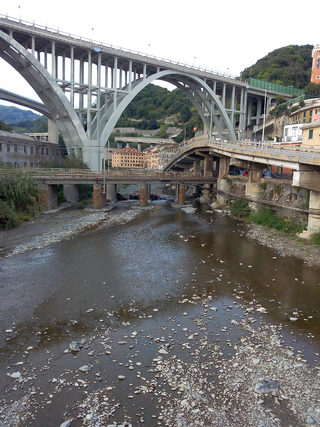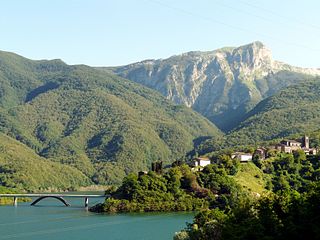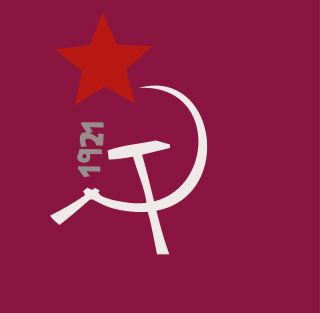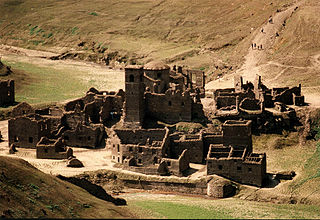
The Rialto is a central area of Venice, Italy, in the sestiere of San Polo. It is, and has been for many centuries, the financial and commercial heart of the city. Rialto is known for its prominent markets as well as for the monumental Rialto Bridge across the Grand Canal.

Giuseppe Valadier was an Italian architect and designer, urban planner and archaeologist and a chief exponent of Neoclassicism in Italy.

The Cerusa is a 10.7-kilometre (6.6 mi) stream of Liguria (Italy).

Fabbriche di Vallico was a comune (municipality) in the Province of Lucca in the Italian region Tuscany, located about 70 kilometres (43 mi) northwest of Florence and about 20 kilometres (12 mi) northwest of Lucca. On 1 January 2014 it was merged with Vergemoli in the new comune of Fabbriche di Vergemoli.

Gallicano is a comune (municipality) in the Province of Lucca in the Italian region Tuscany, located about 70 kilometres (43 mi) northwest of Florence and about 25 kilometres (16 mi) northwest of Lucca.

Molazzana is a comune (municipality) in the Province of Lucca in the Italian region Tuscany, located about 70 kilometres (43 mi) northwest of Florence and about 25 kilometres (16 mi) northwest of Lucca.

Pescaglia is a comune (municipality) in the Province of Lucca in the Italian region Tuscany, located about 70 kilometres (43 mi) northwest of Florence and about 15 kilometres (9 mi) northwest of Lucca.

Stazzema is a comune (municipality) in the Province of Lucca in the Italian region Tuscany, located about 80 kilometres northwest of Florence and about 25 km (16 mi) northwest of Lucca.

Vagli Sotto is a comune (municipality) in the Province of Lucca in the Italian region of Tuscany, located about 90 kilometres northwest of Florence and about 35 kilometres (22 mi) northwest of Lucca.

Vergemoli was a comune (municipality) in the Province of Lucca in the Italian region Tuscany, located about 80 kilometres (50 mi) northwest of Florence and about 25 kilometres (16 mi) northwest of Lucca. On 1 January 2014 it was merged with Fabbriche di Vallico in the new comune of Fabbriche di Vergemoli.

The Labin Republic was a short-lived self-governing republic that was proclaimed by miners from the Istrian city of Labin on March 2, 1921 during a mining strike. It was created in what has been described as the world's first anti-fascist uprising.
Antonio Abbondi generally known as Scarpagnino was an Italian architect of the Renaissance period, active mainly in Venice.

Lago di Vagli is a lake in the Province of Lucca, Tuscany, Italy. It was created in 1953 after the construction of a dam. It houses a depopulated village, the Fabbriche di Careggine, which becomes reachable when the basin is emptied for maintenance. The population was transferred in new residences built in the nearby Vagli Sotto.

City of Vicenza and the Palladian Villas of the Veneto is a World Heritage Site in Italy, which protects buildings by the architect Andrea Palladio. UNESCO inscribed the site on the World Heritage List in 1994. At first the site was called "Vicenza, City of Palladio" and only buildings in the immediate area of Vicenza were included.

Voltri is a quartiere of the Italian city of Genoa, located 17 kilometres (10.6 mi) west of the city centre. It was formerly an independent comune.
The Garfagnina or Garfagnana is an indigenous breed of domestic goat from the mountainous Garfagnana area north of Lucca, in Tuscany in central Italy, from which it takes its name. It is raised in that area, in the comuni of Camporgiano, Careggine, Castelnuovo di Garfagnana, Fosciandora, Minucciano, Pieve Fosciana, Vergemoli and Villa Collemandina; in the comuni of Bagni di Lucca, Barga, Coreglia Antelminelli and Fabbriche di Vallico in the Media Valle del Serchio; and in the historic area of the Controneria, to the north-east of Bagni di Lucca. It may also be known as the Capra della Media Valle del Serchio or as the Capra della Controneria. It is probably the last remnant of the Apennine type of goat of Emilia, Liguria and Tuscany.
Events from the year 1920 in Italy.

Fabbriche di Careggine was a village in Tuscany, Italy that was destroyed by construction of the Lago di Vagli reservoir in 1946. The village had been established in 1270. The village is submerged under 34 million cubic meters of water and its structures — homes, churches and cemeteries — are still preserved. The village is occasionally seen when the lake is drained to conduct maintenance work. The village was seen above water in 1994 and in 2020 it was reported that the village would be uncovered again in 2021, after 27 years underwater.


















